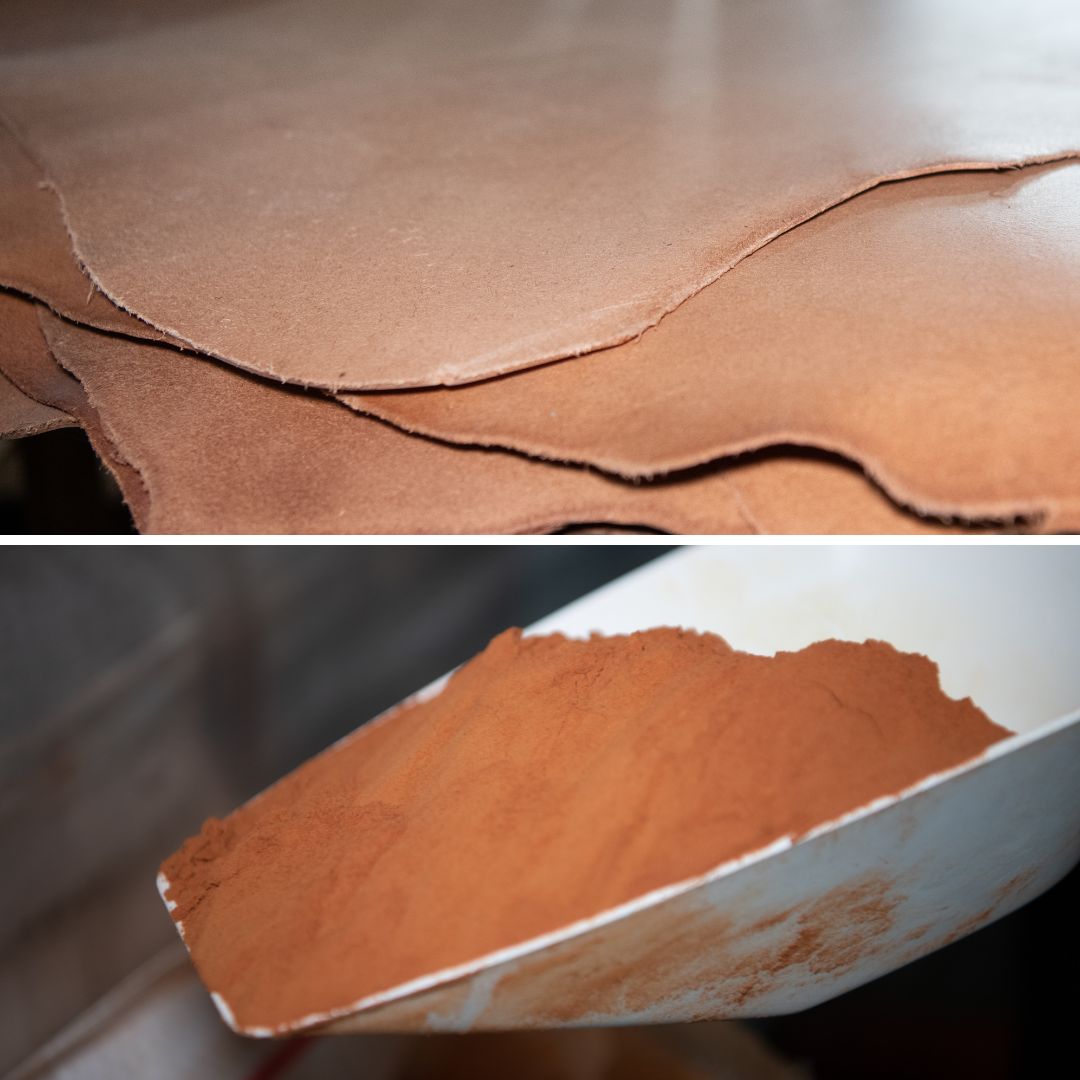
Is leather a sustainable and environmentally friendly material? The production and use of leather, in many ways, gets a bad press from radical environmentalists. There are many benefits to be weighed up in the production and use of leather. On closer inspection, it is even easy to call it sustainable and environmentally friendly, and we'll tell you all about it.
Leather and animal husbandry
Are animals bred for leather production?

Leather production is the result of agri-food production. The main sources of animal skins are cattle 69%, sheep 13%, goats 11% and pigs 6%. Cows, sheep, lambs, goats and pigs are not bred at all for their skins.
Leather is a by-product of our food chain. So, as long as we consume meat, leather making will continue to be a way of recycling food scraps, which would otherwise be wasted or burnt.
Only "exotic" animals are bred for their skins, such as lizards and crocodiles. The production of exotic leathers represents about 0.2% of the world leather production.
According to Leather Naturally, modern leather manufacturing recycles about 270 million cattle hides per year. It is currently estimated that leather production saves 7.3 million tonnes of cattle hides alone and a total of about 10 million tonnes per year. This represents a huge amount of potential waste transformed into a versatile and usable material.
A May 2021 US report commissioned by the Leather & Hide Council of America (L&HCA), based on 25 years of government data, led by Dr Gary W. Brester, Professor Emeritus at Montana State University, shows that using leather does not mean more cattle are being raised. Moreover, if leather production stopped, the environmental impact would be very significant: the burning or disposal in landfills of millions of hides.
Mr Steve Sothmaan, L&HCA forecaster, explains why this report was conducted: "As the world's populations become more urbanised, we have less understanding of how agriculture works. This leads to misconceptions, for example that not producing leather would be good for the environment and would mean smaller dairy and meat industries, or the extreme, that there are 'leather farms' that raise livestock solely for the purpose of leather production."
Does animal husbandry have an impact on the climate?
The methane emitted by ruminants such as cattle, sheep and goats is recycled into carbon in plants and soil, in a process known as the biogenic carbon cycle. This is an important natural cycle that occurs from the beginning of life.
Cows (and other ruminants such as sheep) are often linked to climate change because they emit methane, a powerful greenhouse gas. But the fact is that this methane is part of a natural - or biogenic - carbon cycle, in which methane breaks down into carbon dioxide (Co2) and water after about 12 years. The grass then absorbs the Co2 through photosynthesis, the cows eat the grass and the cycle continues. While the natural carbon cycle between cows, plants and the atmosphere takes place over a relatively short period of time (about 12 years), CO2 from fossil fuel combustion remains in the atmosphere for potentially thousands of years.
This means that if methane emissions from livestock remain stable or decrease, fossil fuels have a much greater and long-term impact on our climate than methane from cows. With a stable livestock population, the amount of methane produced actually balances the methane that decomposes from the atmosphere. Meat & Livestock Australia has created a simple animation that explains the difference between the environmental impact of cow methane and fossil fuel carbon dioxide:
With regard to the climate, it is also worth mentioning water consumption. This RTBF article sheds light on the different references taken into account to assess the right consumption: How many litres of water does it really take to produce one kilo of beef?
Water management in modern tanneries is in line with the UN's sustainable development goal on water. Most European tanneries had already implemented various working methods that helped them reduce their water consumption. But on the whole, we can't do without water, so it all depends on how it's extracted, treated and returned. Better water management and a smaller footprint for leather. This is explained by One4leather in its article: Better water management and a smaller footprint for leather.
What about animal welfare?
 Whatever our beliefs, animals are slaughtered in slaughterhouses according to precise standards and processes that do not cause any pain. Abusive practices are denounced and illegal. The animal does not suffer in the legal process.
Whatever our beliefs, animals are slaughtered in slaughterhouses according to precise standards and processes that do not cause any pain. Abusive practices are denounced and illegal. The animal does not suffer in the legal process.In order to harvest hides of sufficient thickness, with a high fibre density as well as a hide grain free of barbed wire, without varons and with few life defects, responsible European cattle farms with cattle that have a close relationship with the farmer are a must. These cattle farms are in grassy meadows, in the hills, in alternating seasons and live the seasons. The hides we recover from slaughterhouse waste represent a very good quality of hide for making saddle leather. This contributes, in turn, to the company's ethical approach. Traceability back to the farming method is at the heart of the tanners' issues at the moment but at this stage it is still difficult to trace back beyond the slaughterhouse.
Is leather a sustainable material?
Leather has a long life, especially full grain leather, which becomes more beautiful over time, acquiring a depth of patina and a wear pattern unique to each user. As we consciously look for ways to reduce our consumption, leather fits right in with the 'buy less, buy better' philosophy. Investing in quality leather products is an investment in the future. The leather industry is an excellent example of thecircular economy.

Is leather a recycled and recyclable material?
Yes, first of all leather is a recycled material because as explained above leather is a material transformed into a quality product, whereas it could be a waste product to be disposed of. And secondly, it is recyclable because for years and thanks to new technologies, many materials and accessories have been made from leftover leather.
The leather trimmings from the manufacturing process can be reused as padding (in boxing bags for example), or combined with other materials to make composite products such as leather board, which is used for insoles and heel inserts in shoes.
Is leather a biodegradable material?
Yes, leather is a natural material, unlike synthetic plastics derived from oil. At the end of its life, and depending on the type, leather will biodegrade naturally. It will decompose in a natural environment in 25 to 45 years. Plastics take hundreds of years to biodegrade and produce microplastics that harm the environment.
Is leather an environmentally friendly material?
With all the above explanations, we can say that leather is an ecological material, natural, renewable, biodegradable, and thanks to new technologies, environmentally friendly, and minimising its impact on the environment. Due to the important environmental controls in place, such as the reuse of waste water, the impact of leather manufacturing is very low.
Much less waste is generated due to the high durability and strength of leather compared to other equivalent synthetic materials. Almost every country in the world produces leather, and the vast majority do so in a transparent and responsible manner. The chemicals used in leather production are highly regulated.








